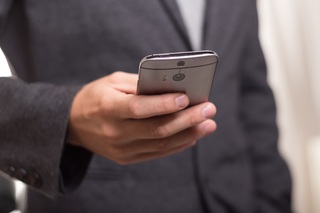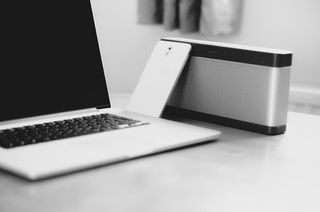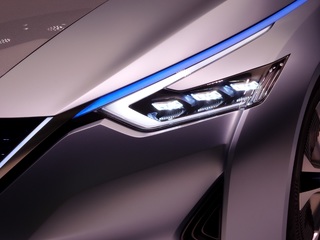Devices and Gadgets that Can Work with IoT
 The gadgets that can work with IoT relate to different spheres of our life, including social, household, commercial, and communicative activities. All the areas of our life, sooner or later, will be filled with different devices that can help or ease our living. The most simple and common smart device you probably use now is your smartphone. People take their phones with them all over the place. Smartphones have lots of sensors that track our geolocation, gyroscopes, touch and fingerprints, react to our voice, and it is only the beginning of the list, as the possibilities and potential of our smartphones are huge.
The gadgets that can work with IoT relate to different spheres of our life, including social, household, commercial, and communicative activities. All the areas of our life, sooner or later, will be filled with different devices that can help or ease our living. The most simple and common smart device you probably use now is your smartphone. People take their phones with them all over the place. Smartphones have lots of sensors that track our geolocation, gyroscopes, touch and fingerprints, react to our voice, and it is only the beginning of the list, as the possibilities and potential of our smartphones are huge.
We also have different small trackers, like fitness or heart-rate trackers, connected with our smartphone to transfer collected data there. Smartwatches can do the same as fitness trackers and lots of other stuff if they are connected with our smartphones. We are close to wearing smart clothing, as most processors nowadays have the prefix ‘micro -’ and soon even the sensors may be ‘sewed’. In addition, we can even put sensors on our pets to track their location or body characteristics. Don’t forget we already have cameras that automatically detect needed objects or people and transfer this data to the Internet. We have scales that track our weight, save the history of it, and have a ‘share’ button for social networks. We can manage our computers and smartphones with voice regulations. As you can see, technology adjusts to our needs more than even 5 years ago.
 Many things at our home, like thermostats, water supply, safety cameras, and sensor lights, can collect information on a regular basis to create patterns that relate to you. All of this information is transferred via Internet to your PC or phone in case something ‘out of the pattern’ happens or if there is a problem. Many devices are learning to react in different situations to find out whether it is a problem. If garage doors work in correlation with your doors and are connected, you can use your phone, not keys. Stoves and ovens with WiFi can be watched and remotely activated or deactivated. One of the most desired items is a smart fridge that tracks the goods inside and creates a list of deficit goods, creates recipes with what you have inside, or even makes online order in stores if the fridge has such settings. And it is available nowadays, but needs to be perfected.
Many things at our home, like thermostats, water supply, safety cameras, and sensor lights, can collect information on a regular basis to create patterns that relate to you. All of this information is transferred via Internet to your PC or phone in case something ‘out of the pattern’ happens or if there is a problem. Many devices are learning to react in different situations to find out whether it is a problem. If garage doors work in correlation with your doors and are connected, you can use your phone, not keys. Stoves and ovens with WiFi can be watched and remotely activated or deactivated. One of the most desired items is a smart fridge that tracks the goods inside and creates a list of deficit goods, creates recipes with what you have inside, or even makes online order in stores if the fridge has such settings. And it is available nowadays, but needs to be perfected.
Smart cities are the thing people talk about right now, though it was a concept a few years ago. There are projects of full metro communication filled with sensors and advanced technology. Sensors are perfect to track the usage of utilities and to make taking of gas and electricity readings automatic in each house. IoT opens huge possibilities for environment tracking, including road situation, level of hazardous substances in the air, indicating total power or water usage. Road sensors could track traffic and possible problematic parts of the road. The smart vehicle moving on the road would get notifications about the real-time situation on the closest road on the route. City infrastructure can be massively enhanced with IoT technology. Traffic lights can adjust to real-time situation; garbage cans can be tracked to find out when they need to be taken out. Parking lot can send information about its availability. Nowadays, huge scientific technological laboratories work on creation of nano-trackers that could be located even in building materials to track the condition of the infrastructure to prevent serious problems, like ruination of roads, bridges, and drainage system failures.
 One of the most important aspects of connected devices development concerns cars. We have had many new things in the past, like GPS and automatic pay and pass through toll stations, but the future with its sensors is bringing more. Connected cars can entertain the driver, drive the car automatically if something happens or if you want to set it like this, scan the road and monitor surroundings to avoid accidents, call emergency or road services if needed. Even now, we have automobiles that can unlock doors and start remotely, so the person can simply jump into the car and drive or be given a ride.
One of the most important aspects of connected devices development concerns cars. We have had many new things in the past, like GPS and automatic pay and pass through toll stations, but the future with its sensors is bringing more. Connected cars can entertain the driver, drive the car automatically if something happens or if you want to set it like this, scan the road and monitor surroundings to avoid accidents, call emergency or road services if needed. Even now, we have automobiles that can unlock doors and start remotely, so the person can simply jump into the car and drive or be given a ride.
Healthcare is probably the top one among others in smart devices usage. The work on enhancing the human body through devices is always relevant and ever-developing. Physicians and people who take care of others will track body condition, temperature, substances, signs of illnesses, and other crucial indicators in real-time. It is a possibility to prevent illnesses or to provide help just in time. More importantly, it gives old people a chance to live healthier and more self-sufficient lives. Mounted sensors all over the hospital rooms can provide important data about patients. People are working on smart rugs that detect falls and nano-trackers that can be harmlessly put into the body.
Building and manufacturing are the spheres that will gain large income with unsupervised activity. GE experimented putting sensors into ceramic mix to understand when the substance is in the best ratio bringing the best material. So, they tried to find out which indicator should be supervised. As a result, they have decreased the destruction and defects of their mix. With such advanced micro trackers, it is possible to follow the condition of the substance and materials and its correspondence to the standards set from the beginning until the end of the production cycle. Such thorough following of the manufacturing process can be beneficial for any business. Offices can cut down on energy consumption and enhance security systems. Inventory checking sensors will help to restock when needed. In agriculture, deposits of crops can be tracked on their condition. Also, the soil’s level of nutrition and general condition can be monitored through such tracking systems. Tracking possibilities for livestock are also numerous.